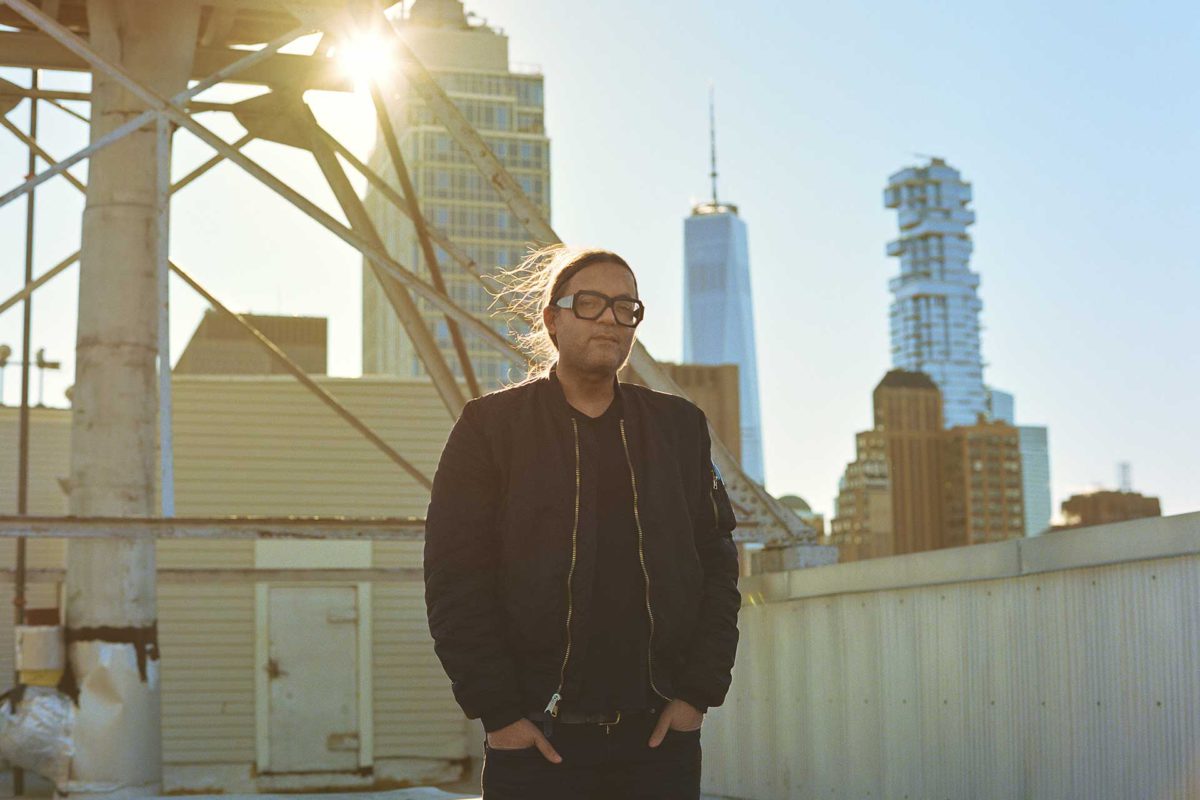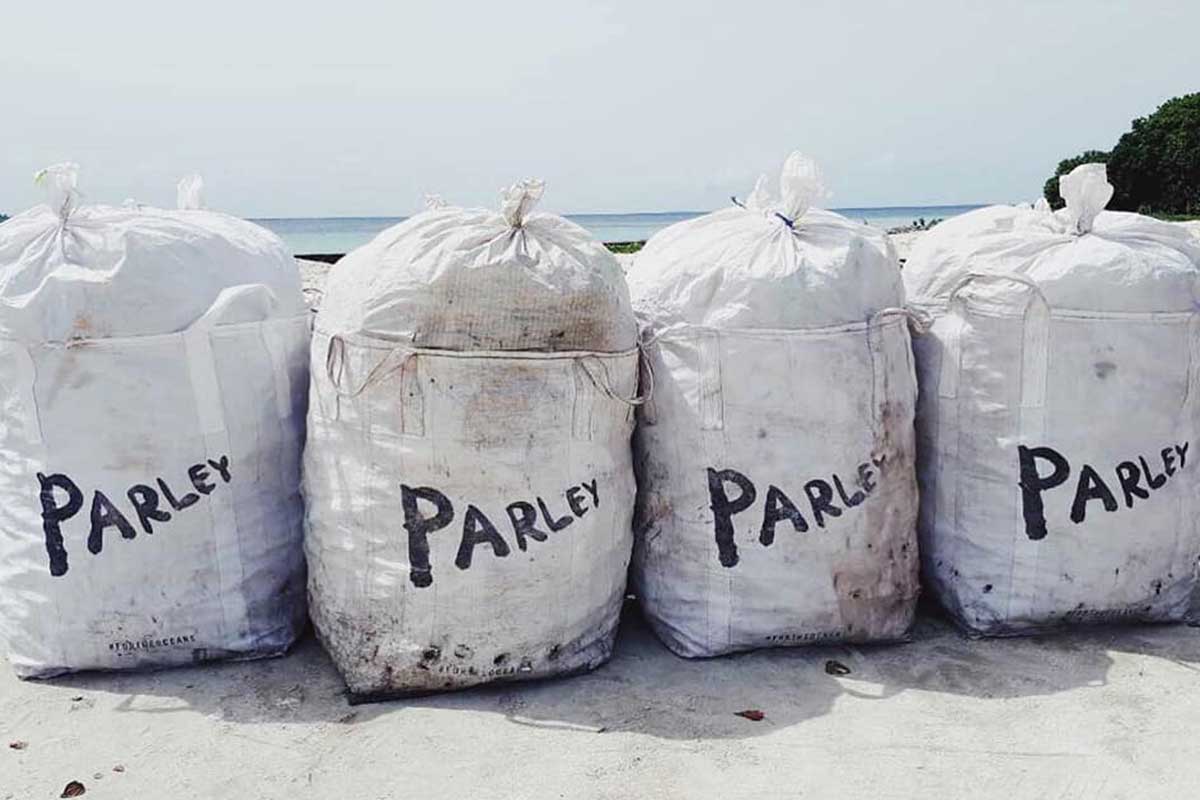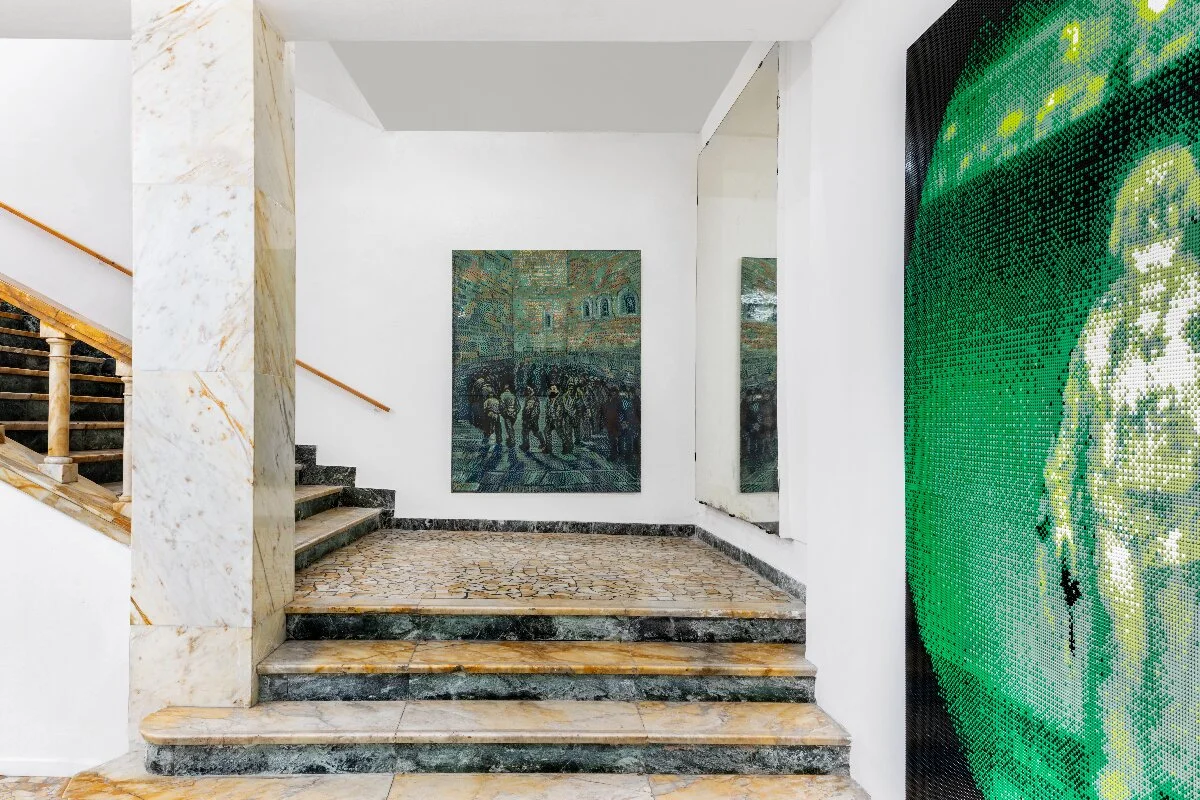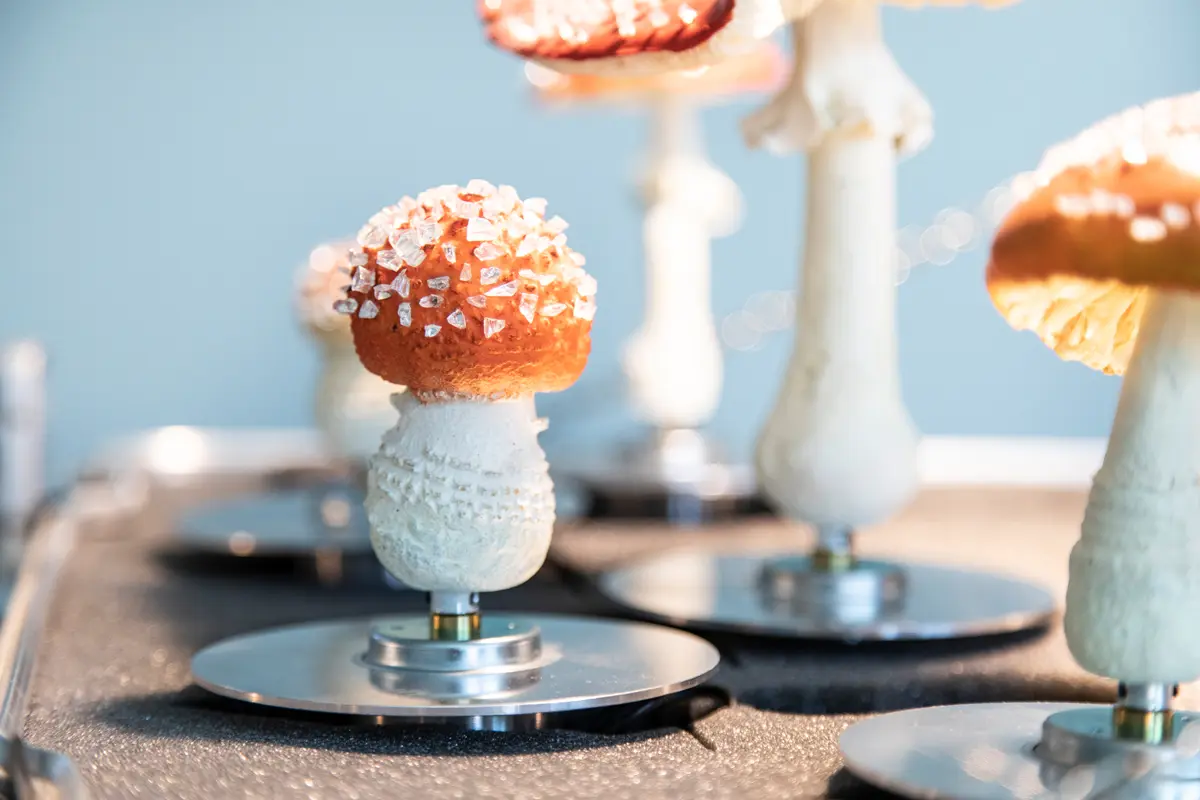Every second breath we take is generated by the oceans – we need to start having blue dreams: a dialogue between creatives on plastic pollution
Parley for the ocean – fighting against oceans destruction
Every year an estimated 8 million metric tons of plastic trash makes its way into the world’s oceans. While dilution might have been the most practiced ‘solution’ to pollution in the past, we can no longer run from the rubbish: microplastics are now widely present in our food chain and drinking water. Humanity relies on the oceans for both air and food, but our patterns of consumption and disposal are imperiling these natural processes. Alarmed by these trends, New York-based Cyrill Gutsch founded Parley for the Oceans in 2012 as a collaboration network for leaders, scientists, journalists, and designers – all thinkers working on solutions to end the destruction of our oceans.
Xerxes Cook is a writer and editor who contributes to art and design magazines. True to Parley’s collaborative nature, Gutsch and Cook have worked together on Parley projects on small islands plagued by a deluge of plastic waste. Their conversation, condensed and edited here for clarity, explores the fragility of our oceans and how small islands, along with the material revolution, can deliver solutions to the plastic problem.
Captain Paul Watson of Sea Shepherd meeting with Cyrill Gutsch
KN: What brought both of you to the environmentalism field and how did you first start working together?
CG: There always has been something in my DNA that says we should take care of the environment, but there’s also something cynical, where I thought we’re going to destroy this planet anyway. In 2012 I met Captain Paul Watson of Sea Shepherd and that changed this perspective. I was alarmed – my conversation with him gave me insight into the state of the oceans and the planet. He outlined how the oceans could be dead in just a few decades if humanity stayed on the same course and that was something that I could not accept.
XC: I’ve often worked on projects that have a higher purpose to raise awareness of pressing issues. About six years ago, Parley had a team on the ground in Bali and they asked me to come on board and investigate the island’s plastic problem. We traced the water cycle from the highest part of the island, following the rivers all the way down to the sea and in the process, we examined the different kinds of waste and all of the companies producing that waste. It was a deep dive – two weeks of walking in plastic waste that was waist high and going to the landfill every day to learn what wasn’t being recycled and why.
The oceans – Fragile ecosystems
KN: Sharing information and empowering the communities you work in and write about is at the heart of the work both of you do. If the ocean is our life support system, how can this be communicated to people in a memorable way that calls them to action?
CG: One way to connect humans with the sea is to show them the beauty and to create that fascination for what is down there. The oceans are very little explored and if they are, it’s usually for exploitation. The fascination that we have of outer space, such as going to other planets and finding life out there, needs to be created for the alien-like life underwater – the blue magic universe. Art is one way of doing that, but then there are documentaries, film, and narrative.
The best way to create a strong relationship between mankind and the sea is through experiences. We have to learn firsthand the experience of the beauty of the sea in a virtual or in a real way. And the second is logic by understanding and knowing we exist because these animals and creatures out there create the chemistry that allows us to be here. Every second breath we take is generated by the oceans. The most important thing is that we start dreaming blue. We need to have blue dreams.
XC: Yes, we need to show the beauty and fragility of our oceans. There is a quote by Dostoevsky which has been adopted by the environmental movement: Beauty will save the world. The fragility is this alien material, this plastic that’s been introduced to it which is manmade. When we were in Bali we saw horrific scenes of piles of plastic trash on the beaches, but Cyrill was against publishing on this since it’s not fair to cast blame – it’s not a problem that they’ve created, it’s been put on them. There is compassion there for these island nations and also a KN drive to show the beauty of the oceans to get people on board to support the movement.
CG: Jacques Cousteau says, ‘People protect what they love’, and that’s true. The moment you relate to something, the moment you have a dream, and it touches your heart, you are ready to fight for it. If you are developing this empathy for other life forms, it can get rid of this arrogance that we are better than them. The documentary My Octopus Teacher just helped break this barrier – it brought us on eye level with another creature.
The role of the oceans in our lives
KN: Cyrill, the oceans are fragile ecosystems that are facing numerous threats as our global population increases. What are the most concerning issues for you that humanity could tackle in a relatively short time period?
CG: A large number of nations depend on the oceans for income, be it taking life from the oceans as a main protein source or for tourism. There are millions of fishing vessels trying to bring home as much as they can with no regard for bycatch. And you see people who are dynamite fishing and this is damaging vast areas. There are gillnets standing like walls in the sea catching everything even though they were intended only for one type of fish. We’re taking too much life and in a hostile, aggressive and destructive way, often with an environmental toll that is very high. Very rarely are fishers taking into account that the oceans have to replenish, so that life has a chance to come back.
Governments could buy out the fishing industry for long enough to replenish the sea. And on the other side, we are using the oceans as this endless dumpster, this landfill that nuclear weapons, trash, old vessels, trains, cars, tires, and plastic gets thrown into. This has to stop. The state of the oceans right now and of the planet is that we are in this sixth mass extinction event. There are around 400 species going into extinction every day. We have to collaborate with nature and change our eating habits and the way we consume.
Lampoon reporting: the lesson of small island microcosms
KN: Small island states are a microcosm, where the confluence of global stressors are acutely felt due to their relatively small population and land size. Both of you have spent time working on small islands including Bali and the Maldives. What can we learn from them?
CG: Islands are the canary in the coalmine. They are the frontline of our movement because it’s very difficult to be blind to the damages you see in paradise because the contrast is so high. Plastic pollution is a problem in all island states. These are developing countries that don’t have the infrastructure to deal with the problems. And they can’t often answer these threats like plastic, trash, recycling, or separation of waste. They don’t have the capacity to deal with these things and they just create havoc there.
Everything on an island is tangible because you see everything on a small scale. If a problem unfolds you can quickly come to the source. And that allows you to quickly redesign. Small island development states that didn’t go through the same development stages as other countries can jump to a new economy with new infrastructure and green technology. Change can happen faster in these nations and then they can become a blueprint for other nations.
XC: Architect and thinker Rem Koolhaas has this manifesto about the radical potential of the countryside, which can be extended to islands. As the world gets more and more urbanized, the countryside opens up and there is space for experiments in farming and conservation. The future of humanity will be determined by what happens in its rural landscapes rather than its cities. Rural landscapes and islands can be these laboratories for change. Islands have always been sites of experimentation and alternative ways of living. Within literature we see it but also in real life. In literature you have Thomas More’s Utopia which was set on one and Huxley’s last book took place on an imaginary island.
Future Island Nation program
KN: Parley has done a significant amount of work in the Maldives with the Future Island Nation program by building a small recycling center and glass water bottling system to reduce plastic waste going into landfills. Considering how low-lying the Maldives are and how disproportionately they could be affected by sea-level rise, why did you choose to focus your efforts here, Cyrill?
CG: The Maldives stand for something. They stand for this paradise at the end of the world. The ultimate escape. And in the past, you would think if you’re traveling so far, then you’re going to find a place that is still intact and not influenced by all this damage that we’re causing in cities. It’s the ultimate away and focusing on problems that threaten the existence of these islands is questioning the idea of ‘away’. The second piece is that the Maldives are visited by a million people every year. It’s an influential place because the people that go there can afford to go there and they have time to think and learn.
We can tell them that the way they are running their business in other parts of the world has an impact on this place and places like it. We have so much to learn from indigenous people and other people who didn’t lose contact with the sea and with nature. I haven’t given up on the Maldives yet. There is still enough time to turn things around.
KN: Popular island tourist destinations around the world got to press pause on tourists and cruise ships during the pandemic. What happened during this break and what do you think will be the long-term effect? In Key West, we see that residents already voted to limit the size of cruise ships that can come to port.
XC: We have to remember that islands have a great deal of autonomy. One of my favorite answers that I’ve had during an interview in the last few years is when I spoke with the environmental minister for the Balearic Islands in Spain a few years ago when they banned single-use plastics like straws, bags, and cups. I asked him, ‘What’s the biggest challenge?’ And he said, ‘It’s not for me, I don’t have any challenge. The biggest challenge is for the producers and for the supermarkets. The ball is in their court. We banned it, now they have to deal with it’.
CG: The pandemic allows us now to think bigger and more extreme. Before, we didn’t have the imagination to just restrict or stop because we never have seen it happening. Now we see that actions can happen on a large scale. And we see what the benefits are if not so many planes fly or so many boats come to port. There is a lot that suddenly enters our imagination as a possibility.
The urge of a material revolution to tackle the issue of plastic
KN: Recycling is a temporary solution and all of the plastic that has ever been created still exists unless it was burned, which is still a toxic form of disposal. How can the Material Revolution help address this problem?
CG: We have been addicted to fossil fuel-based materials and plastic is one of them. Plastic is a design failure because it’s always toxic. The future is in what we call biofabrication or in biomaterials. Our belief at Parley is that we have to learn from nature and work with the factories that are in nature. There are companies now that are growing concrete with enzymes without any carbon emissions and now there are ways to grow insulation materials, fibers, and flooring with mycelium, the tubular filaments of fungi. We are at the beginning still of biomaterials because there have been no major investments into the industry yet, but this is about to happen very soon.
We are in a new tech phase. After the digital revolution, there’s now a material revolution and green tech and the material revolution will be the next big investment areas. We’re talking about the replacement of polyester and plastic in general and the replacement of anything that is fossil-fuel based. At Parley we came up with a strategy that’s called AIR: Avoid, Intercept and Redesign. We have to avoid harmful substances by limiting them and trying not to use them as best we can, knowing that we can’t totally cut them out, intercept these pollutants from the environment, and then redesign materials and invent new ones. We built Parley as a collaboration effort that is based on creativity and eco-innovation and collaboration. It’s all about finding solutions that replace the old.
Parley for the Ocean commitment
KN: What role can this material revolution play in ending ‘fast fashion’ amid a global economy that pushes for people to consume more and more?
XC: Thinking about the seismic shifts that happened in 2020, there are all these people who aren’t buying work clothes or a Saturday night dress which you’re going to wear once or twice and throw away. We can only hope that 2020 has had a lasting effect on the consumer – that we don’t feel that desire to go out and buy just to buy.
CG: The old definition of success by growth, making more and more, needs to be redefined. It is not right for the fashion industry to make disposable items unless they’re made from a 100 percent renewable feedstock, which doesn’t exist yet. Fast fashion is a wrong thought. It’s about limiting your inventory and being creative with products once you own them – alter them, change them, repair them but definitely buy less.
KN: Parley focuses on working with the creative community, including designers, journalists and artists. Why is this approach important?
CG: The creative community is the core of the movement at Parley and I include science in that. When you’re looking at the issues we’re facing today and the big problems, they’re caused by the economy and business. Business depends on the creative industries. Most of the businesses have been started by creatives – somebody that had an idea. She or he is the best collaboration manager because people trust the artist in the sense of an agenda.
XC: An artist uncovers hidden but universal truths that create an emotional response that is hard to put into language. But you know it’s true because you’ve reacted to it on a deeper, emotional level.
Cyrill Gutsch
Cyrill is an award-winning designer and brand/product developer. In 1998 he created a method called Cross Intelligence, which brings a culture of collaboration to major organizations. In 2012 he decided to focus on a new client vital to us all: the oceans. He founded Parley for the Oceans as a collaboration network for creators, thinkers and leaders to raise awareness for the beauty and fragility of the oceans and to develop and implement strategies that can end their destruction.
Xerxes Cook
Is a writer and editor who contributes to art and design magazines such as 032c, Interview, Purple, and Vogue Italia. Some of his stories have seen him apply the conventions of Brutalist architecture to food, re-wild his child in the Canary Isle of La Gomera, and interview Madonna. Having lived in Saudi Arabia, Thailand, and even Tallahassee, Xerxes is now doing the sensible thing and splitting his time between London and Bali.
Kelsey Novakowski
Is an environmental journalist based In Puerto Rico. Kelsey regularly contributes to National Geographic magazine and covers topics linked to forestry for Lampoon Magazine.




















